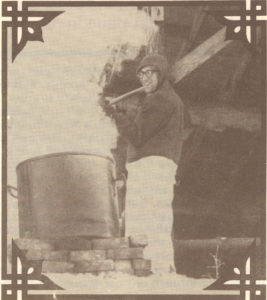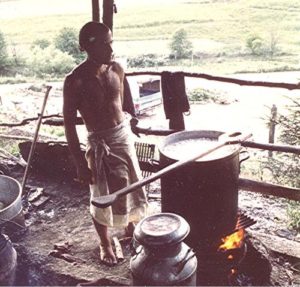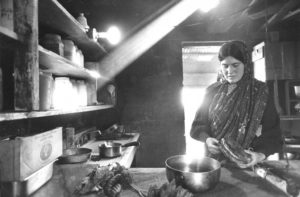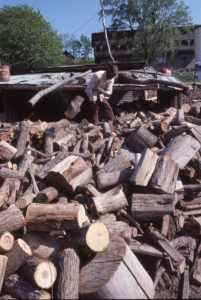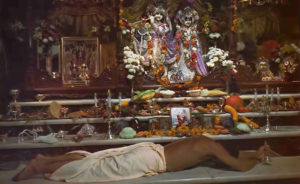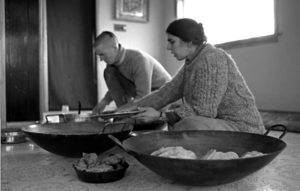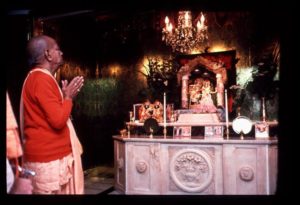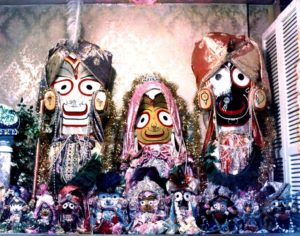NEW VRINDABAN DAYS – CHAPTER 10
NEW VRINDABAN DAYS – CHAPTER 10
As New Vrindaban winds up its celebration for its 50th anniversary (1968 to 2018), begins its 50th year of cow protection (1969 to 2019) as well as the 40th anniversary of the dedication of Srila Prabhupada’s Palace (1979 to 2019), I wrote this series of articles for the Brijabasi Spirit in an attempt to give the reader not only an “understanding,” but more importantly a “taste,” of what life in early New Vrindaban was like – through the stories of one devotee’s personal journey.
The title of this series, “New Vrindaban Days,” is in tribute to the wonderful book “Vrindaban Days: Memories of an Indian Holy Town” written by Howard Wheeler, Hayagriva Dasa. He was one of Srila Prabhupada’s first disciples, a co-founder of New Vrindaban, and, a great writer. As with Hayagriva’s book, this series focuses on a period of time in the 1970’s.
I would also like to acknowledge and thank Chaitanya Mangala Dasa, for spending untold hours assisting me in refining my writing for your reading pleasure.
I have been asked to describe certain aspects of early New Vrindaban Community life such as the nature of the austerities, what it was like for a new person coming here, cooking, anecdotes about particular devotees, etc.
I attempt to tell these stories in some semblance of a chronological order, beginning with my first meeting with devotees in 1968, leading to my arrival in New Vrindaban in late 1973 and carrying through to the official opening of Srila Prabhupada’s Palace in 1979.
This article describes some of my experiences from 1974, the first year I lived in New Vrindaban.
Advaitacharya Dasa
CHAPTER TEN: Fire and Brimstone – Cooking It Up
Although I have given an account of what prasadam is like on a daily basis, I have yet to give the reader insight into what it means to cook for Krishna and His devotees in New Vrindaban.
There are many great cooks in the history of New Vrindaban far more qualified to talk about how New Vrindaban became known for some of the best prasadam in the world. Right now it is left to me and I will try to give both the prasadam, and the wonderful devotees responsible for its preparation, their due.
I will start by acknowledging what I am about to say is no doubt subjective. Regardless, it is also unequivocally true.
Sudhanu is the best festival cook in ISKCON. Vijaya’s potato kachoris cannot be beat. Radhanath (Swami) makes the best sandesh. Candramauli (Swami) prepares the best khoa, Dharmakala the best curd cheesecake and Kuladri (my teacher) the best halavah. Kutila is the best all-around Deity cook, Lajjavati makes the best milk sweets, Bhokta the best baked goods, Amburish the best sweet rice, & Hladini the best cinnamon buns.
No devotee can roll festival ladhus faster, or more uniform in size, than Kripacharya, and besides Taru, the official “prasadam addict,” no devotee loves prasadam more than Maha Yogi.
I’ve heard it said a great cook has the ability to make a preparation taste good, look as good as it tastes, and make exactly the right quantities. A great devotee cook is always cooking with the pleasure of Krishna and His devotees in mind, making it a meditation of love and devotion.
No doubt the qualities I mention above may also be achievable by other wonderful cooks throughout the movement.
I hold firm my assertions about the pioneer New Vrindaban cooks, for the following reasons:
- No other devotees have the luxury to cook these preparations using the sweet milk, butter, and ghee from the wonderful surabhi cows of New Vrindaban. After his first visit, Srila Prabhupada stated: “The milk which we are taking here is not at all comparable with New Vrindaban milk.”
- The preparations they cook do not become mixed with the saliva of the Deities Srila Prabhupada gazed upon, referencing them as the standard of “village beauty” – Sri Sri Radha Vrindaban Chandra.
- Even if they had, I also know that it is unlikely they cooked these preparations day after day, for as many years as the devotees of New Vrindaban did.
- And, here is the absolute show stopper. Even if other ISKCON cooks were fortunate enough to have done all the above, I know they did not make those preparations under the austere conditions I describe below.
The Bahulaban Deity Kitchen of Sri Sri Radha Vrindaban Chandra:
The kitchen is a 12 ft. X 15 ft. cinder block building painted light green. Inside, the floor is made of donated marble, making it unforgiving to stand on for long periods of time, and it is freezing cold all winter. Many of the women that cook in this kitchen experience varicose veins before they are thirty. The counters are also made of marble. While that may seem opulent, in reality they are cold, hard, rough on knives and even rougher on hands in the winter.
In the kitchen are primitive wood stoves, from the late eighteen hundreds. The ventilation is poor and the burning of wood means there is always a hint of smoke in the kitchen. Many of the cooks’ eyes are red, dry & itchy. Some of their tear ducts have been damaged so severely they are unable to cry.
Cooking on wood makes it practically impossible to control the heat. The condition of the stove, the hardness of the wood, how small it has been split, whether it is green or dry, etc., all affect our ability to cook. We don’t have the luxury to turn the gas lower or higher. There is no gas.
Throughout the winter the wood is cut directly outside the kitchen building by devotees like Bhakta Burt (Bhavisyat Das) and Bhakta Chris (Kripamaya Das), who are constantly covered with snow and ice.
Keeping fires going with wet or green wood is practically a feat of magic. If the cook is inattentive for even a minute the fire could go out, or go real low, and that impacts the entire cooking process.
Before these humble kitchen servants can begin cooking their preparations, they often have to deal with a high likelihood the cooks before them were on a tight schedule and moved on to their next service without cleaning up. Washing the cooking utensils is not as easy as one might imagine. Because they are cooking with wood, the pots are covered with a thick coat of black soot.
There is no hot water so a cook is forced to scrub with ice cold water. If they use larger pots they can’t be washed in the kitchen sink and must be carried out of the kitchen to the “pot room,” which is actually the furnace room in the cellar of the hundred year old farmhouse we have converted into a temple.
My first experience of washing pots did not involve the luxury of hot water, steel wool, or even dish soap. Instead it did it by scraping the bottom of the pot with a fist sized flat rock, using ashes from the wood fire as an abrasive cleanser.
Sri Sri Radha Vrindaban Chandra receive seven bhoga offerings a day. The lunch offering alone consists of more than a dozen dishes. The schedule is grueling. One cook, or team of cooks, finishes an offering when another cook or team arrives to begin the next one. These austere conditions continue not just for weeks, not just for months, not just for years – but for more than a decade. These devotees become expert in their service.
The Vrindaban Kitchen of Sri Sri Radha Vrindaban Nath:
The cellar of the original farmhouse at the Vrindaban farm can only be compared to what one might imagine a dungeon to be like. Behind the old, small farmhouse, which houses both the temple and the brahmachari ashram, one enters the cellar through an old wooden plank door.
The foundation of the building is made of large cut limestone which form the walls of the cellar. The ceiling is no more than six feet high. The floor is rough concrete. Making a sharp left turn through a doorway is the Deity kitchen. Conditions in this kitchen are even more harsh than the one at Bahulaban. The stoves are older, the ventilation worse, the space smaller. All the problems of dealing with wood fires are magnified here.
This kitchen is almost always inhabited by Candramauli (Swami) whose eyes are also damaged from excessive contact with the wood smoke. Candramauli is from New Jersey and both he and his sister Kunjari live in New Vrindaban. Candramauli is the primary cook for Sri Sri Radha Vrindaban Nath. His specialty is various milk sweets such as khoa, pera, burfi, and more.
Although Radhanath (Swami) is the head Pujari, he also makes the Deity’s sandesh. Sandesh is a milk sweet made from curd that has been hand kneaded until it is silky smooth. Radhanath perfected not only the art of cooking sandesh but he also makes what I can only describe as Neopolitan Sandesh. Even though each piece is no more than one inch thick Radhanath has mastered layering it in three different colors. It is perfectly layered as if it has been made using precision machinery when in actuality it has been painstakingly cooked on an ancient and defective wood burning stove and hand layered and rolled in a dungeon like root cellar.
Whenever Kirtanananda Swami travels to see Srila Prabhupada he brings Radhanath’s sandesh with him for His Divine Grace. Srila Prabhupada personally described Radhanath’s preparation as the most “first class sandesh I have tasted in your country.” One time the Swami traveled to India and forgot to bring a box with him. When Srila Prabhupada asked for some sandesh a package was promptly shipped to him from New Vrindaban via express mail.
The Madhuban Kitchen of Sri Sri Radha Madhava and Lord Jagannath:
From an external perspective, Madhuban is the least regarded of the three prominent temples of New Vrindaban. Only a handful of devotees live there and it generally gets the lowest amount of attention. Hladini Devi Dasi, who although living in a ramshackle old farmhouse, considers herself to be residing in a celestial palace in the association of her beloved Lord Jagannath. She cooks the offerings with help of Ruparamesvari Dasi. Rupa has written about her experiences in the kitchen with Hladini and hopefully it will be published as well. For those who remember Hladini and her cooking, I have only these words: Lord Jagannath’s huge, smoky flavored cinnamon buns.
The Devotee Prasadam Kitchen at Bahulaban – aka “The Pits:”
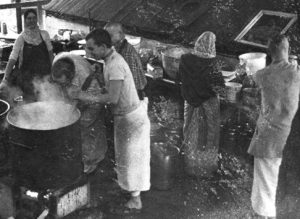
Bahulaban Pits, from let to right: Sobhavati, Sankirtan, Bhokta, Advaita, Kutila, Kuladri, mid 1970s
In a community of devotees all prasadam is prepared first and foremost for the pleasure of Lord Krishna. As the Bahulaban kitchen became too small to cook everything in, sometime in late 1973, a corrugated steel roof was hung off one side of the building and all preparations intended for the devotees began to be cooked outside over open wood fires. New Vrindaban residents affectionately refer to the outdoor kitchen arrangement as “the pits.”
The pits contain four burners that are at different times made of either stacked bricks or fifty five gallon steel drums, cut in half. The bricks, having too much water content, often explode, spreading the equivalent of shrapnel around the area. Although a cook’s lower legs are scorched, the rest of our body is freezing due to the fact we are cooking outdoors with no shelter but a tin roof over our head. And, as I’ve already mentioned, there was more black soot than the amount encountered by the London chimney sweeps of a Charles Dickens tale.
Giving a full idea of what cooking in “the pits” was like It could fill an entire book, but since I am only writing a short chapter I will leave the reader with a few mental images to ponder.
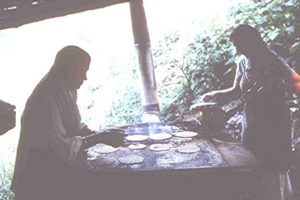
Ladies preparing chapatis in the outdoor kitchen at Bahulaban 1976 or 77. On left, Lakhima; Right, Sobhavati.
Women, like Shyama, Madri and others, rolling hundreds of chapatis outdoors daily in the early morning darkness of winter… Bhokta leaping into a barrel of whey to extinguish his dhoti that caught fire… Sobhavati’s sari catching flame and her spending countless hours cleaning the large blackened pots with cold water in the grungy furnace room… Cooks starting breakfast prasadam before Mangala Arti at 4 AM, first having to drag forty gallons of water twenty feet from the pot room and then starting outdoor fires with wood covered in ice….
So again, I stand behind my statement, which is no doubt subjective – yet, unequivocally true: These cooks – and the prasadam they prepare – are amazing examples of the mood of deep surrender among the pioneer New Vrindaban devotees.
Even more simply put, for me, they were, are, and will forever be, the best.
All glories to their sincere service and devotion!
—————————————————————————————-
Did you miss a previous chapter? Click the links below and catch up:
Chapter 1: Every Journey Begins With a Single Step
Chapter 2: Srila Prabhupada – Jaya Radha Madhava
Chapter 3: Captured by the Beauty of Sri Sri Radha Vrindaban Chandra
Chapter 4: Fired Up – We Depend On Sri Sri Radha Vrindaban Chandra
Chapter 5: The New Vrindaban Landscape – January 1974
Chapter 9: The Death of Vedic Civilization
Stay tuned for Chapter 11: A Lifelong Pact (Sudhanu and Advaitacharya)
The next monthly installment will be posted February 2019!

